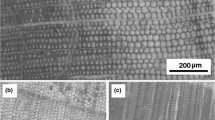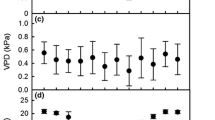Abstract
Key message
Although spatial variations in sap flux changed seasonally in cedar trees, neglecting these seasonal changes generally resulted in less than 10% errors in year-round tree transpiration estimates.
Abstract
Spatial and temporal variations in sap flux (F d ) affect the accuracy of year-round individual tree water use (Q) estimates. We aimed to determine seasonal changes in radial and azimuthal variations in F d and to evaluate their potential impacts on year-round Q estimates for humid subtropical forest trees. We measured F d using 38 probes in eight Cryptomeria japonica trees in Taiwan from July 2010 to May 2011. During the study period, the ratio of inner F d to outermost F d (R r ) ranged between 0.29 and 0.68. The ratio of mean outermost F d to that at one direction (R a ) ranged between 0.36 and 1.89. The seasonal patterns were inconsistent among individuals. We compared year-round Q estimates derived from multi-sensor measurements (Q m ) with those derived from measurements at a certain position with constant correction factors for radial (Q r ) or azimuthal (Q a ) patterns of F d determined from the summer measurements. This simple exercise revealed consistent relationships between Q m and Q r year-round (<10% error), suggesting that seasonal changes in the radial profiles of F d had little effect on Q estimates. Although using a constant correction factor for azimuthal variations led to 20–40% errors in Q a of some individuals with large azimuthal variations (i.e., CV > 0.49), five out of eight individuals had less than 10% errors in their Q a estimates. These results suggested that constant correction factors can be used for radial variations in year-round Q estimates, but are not applicable for azimuthal variations in individuals showing large azimuthal variations of F d .







Similar content being viewed by others
References
Chiu C-W, Kume T, Komatsu H, Tseng H, Wey T-H, Otsuki K (2016) Azimuthal, radial, and tree-to-tree variations in sap flux affect stand transpiration estimates seasonally in a Cryptomeria japonica forest, central Taiwan. J Forest Res. doi:10.1007/s10310-016-0525-6 (in press)
Clearwater MJ, Meinzer FC, Andrade JL, Goldstein G, Holbrook NM (1999) Potential errors in measurement of nonuniform sap flow using heat dissipation probes. Tree Physiol 19(10):681–687. doi:10.1093/treephys/19.10.681
Cohen S, Wheeler J, Holbrook NM (2012) The radial and azimuthal (or tangential) distribution of sap velocity in tree stems—why and can we predict it? In: Sebastiani L, Tognetti R, Motisi A (eds) VIII international symposium on sap flow. International society for horticultural science, Leuven, pp 131–137
Delzon S, Sartore M, Granier A, Loustau D (2004a) Radial profiles of sap flow with increasing tree size in maritime pine. Tree Physiol 24(11):1285–1293
Delzon S, Sartore M, Burlett R, Dewar R, Loustau D (2004b) Hydraulic responses to height growth in maritime pine trees. Plant Cell Environ 27(9):1077–1087. doi:10.1111/j.1365-3040.2004.01213.x
Ewers BE, Gower ST, Bond-Lamberty B, Wang CK (2005) Effects of stand age and tree species on canopy transpiration and average stomatal conductance of boreal forests. Plant Cell Environ 28:660–678
Fiora A, Cescatti A (2008) Vertical foliage distribution determines the radial pattern of sap flux density in Picea abies. Tree Physiol 28(9):1317–1323
Ford CR, Goranson CE, Mitchell RJ, Will RE, Teskey RO (2004a) Diurnal and seasonal variability in the radial distribution of sap flow: predicting total stem flow in Pinus taeda trees. Tree Physiol 24(9):941–950
Ford CR, McGuire MA, Mitchell RJ, Teskey RO (2004b) Assessing variation in the radial profile of sap flux density in Pinus species and its effect on daily water use. Tree Physiol 24(3):241–249
Granier A (1985) Une nouvelle méthode pour la mesure du flux de sève brute dans le tronc des arbres. Ann Sci For 42(2):81–88 (in French)
Green SR, Clothier BE (1988) Water use of kiwifruit vines and apple trees by the heat-pulse technique. J Exp Bot 39:115–123
Guan BT, Lin ST, Lin YH, Wu YS (2007) No initial size advantage for Japanese cedars in crowded stands. Forest Ecol Manag 255(3–4):1078–1084
Hatton TJ, Moore SJ, Reece PH (1995) Estimating stand transpiration in a Eucalyptus populnea woodland with the heat pulse method: measurement errors and sampling strategies. Tree Physiol 15(4):219–227
Hernandez-Santana V, Fernández JE, Rodriguez-Dominguez CM, Romeroa R, Diaz-Espejoa A (2016) The dynamics of radial sap flux density reflects changes in stomatal conductance in response to soil and air water deficit. Agric Forest Meteorol 218–219(15) 92–101
Hirose S, Kume A, Takeuchi S, Utsumi Y, Otsuki K, Ogawa S (2005) Stem water transport of Lithocarpus edulis, an evergreen oak with radial-porous wood. Tree Physiol 25(2):221–228. doi:10.1093/treephys/25.2.221
Komatsu H, Katayama A, Hirose S, Kume A, Higashi N, Ogawa S, Otsuki K (2007) Reduction in soil water availability and tree transpiration in a forest with pedestrian trampling. Agr Forest Meteorol 146:107–114
Komatsu H, Shionohara Y, Kumagai T, Kume T, Tsuruta K, Xiang Y, Ichihashi R, Tateishi M, Shimizu T, Miyazawa Y, Nogata M, Laplace S, Han T, Chiu C-W, Ogura A, Saito T, Otsuki K (2014) A model relating transpiration for Japanese cedar and cypress plantations with stand structure. Forest Ecol Manag 334:301–312
Köstner B, Biron P, Siegwolf R, Granier A (1996) Estimates of water vapor flux and canopy conductance of Scots pine at the tree level utilizing different xylem sap flow methods. Theor Appl Climatol 53:105–113
Kume T, Komatsu H, Kuraji K, Suzuki M (2008) Less than 20-min time lags between transpiration and stem sap flow in emergent trees in a Bornean tropical rainforest. Agric For Meteorol 148(6–7):1181–1189. doi:10.1016/j.agrformet.2008.02.010
Kume T, Otsuki K, Du S, Yamanaka N, Wang Y-L, Liu G-B (2012) Spatial variation in sap flow velocity in semiarid region trees: its impact on stand-scale transpiration estimates. Hydrol Process 26:1161–1168
Kume T, Laplace S, Komatsu H, Chu JR (2015) Transpiration in response to wind speed: can apparent leaf-type difference between conifer and broadleaf trees be a practical indicator? Trees 29:605–612
Kume T, Tsuruta K, Komatsu H, Shinohara Y, Katayama A, Ide J, Otsuki K (2016) Differences in sap flux based stand transpiration between upper and lower slope positions in a Japanese cypress plantation watershed. Ecohydrology. doi:10.1002/eco.170 (in press)
Laplace S, Kume T, Chu CR, Komatsu H (2013) Wind speed response of sap flow in five subtropical trees based on wind tunnel experiment. Br J Clim Change 3(2):160–171
Legendre P, Legendre L (1998) Numerical ecology. Number 20 in Developments in Environmental Modelling, 2nd edn. Elsevier, Amsterdam
Lopez-Bernal A, Alcantara E, Testi L, Villalobos FJ (2010) Spatial sap flow and xylem anatomical characteristics in olive trees under different irrigation regimes. Tree Physiol 30:1536–1544. doi:10.1093/treephys/tpq095
Lu P, Muller WJ, Chacko EK (2000) Spatial variations in xylem sap flux density in the trunk of orchard-grown, mature mango trees under changing soil water conditions. Tree Physiol 20(10):683–692
Moon M, Kim T, Park J, Cho S, Ryu D, Kim HS (2015) Variation in sap flux density and its effect on stand transpiration estimates of Korean pine stands. J Forest Res 20:85–93. doi:10.1007/s10310-014-0463-0
Moore GW, Bond B, Jones JA, Meinzer FC (2010) Thermal-dissipation sap flow sensors may not yield consistent sap-flux estimates over multiple years. Trees 24:165–174
Nadezhdina N, Čermák J, Ceulemans R (2002) Radial patterns of sap flow in woody stems of dominant and understory species: scaling errors associated with positioning of sensors. Tree Physiol 22(13):907–918
Nishizono T, Kitahara F, Iehara T, Mitsuda Y (2014) Geographical variation in age-height relationships for dominant trees in Japanese cedar (Cryptomeria japonica D. Don) forests in Japan. J Forest Res 19(3):305–316
Oren R, Sperry JS, Katul GG, Pataki DE, Ewers BE, Phillips N, Schäfer KVR (1999) Survey and synthesis of intra- and interspecific variation in stomatal sensitivity to vapour pressure deficit. Plant Cell Environ 22:1515–1526
Phillips N, Oren R, Zimmermann R (1996) Radial patterns of xylem sap flow in non-, diffuse- and ring-porous tree species. Plant Cell Environ 19(8):983–990
Phillips N, Bond BJ, McDowell NG, Ryan MG (2002) Canopy and hydraulic conductance in young, mature and old Douglas-fir trees. Tree Physiol 22:205–211
Poyatos R, Čermák J, Llorens P (2007) Variation in the radial patterns of sap flux density in pubescent oak (Quercus pubescens) and its implications for tree and stand transpiration measurements. Tree Physiol 27(4):537–548
R development Core Team (2016) R: a language and environment for statistical computing. R Foundation for Statistical Computing, Vienna. https://www.R-project.org/. Accessed 20 Dec 2016
Sato T, Oda T, Igarashi Y, Suzuki M, Uchiyama Y (2012) Circumferential sap flow variation in the trunks of Japanese cedar and cypress trees growing on a steep slope. Hydrol Res Lett 6:104–108
Shinohara Y, Tsuruta K, Ogura A, Noto F, Komatsu H, Otsuki K, Maruyama T (2013) Azimuthal and radial variations in sap flux density and effects on stand-scale transpiration estimates in a Japanese cedar forest. Tree Physiol 33:550–558
Steppe K, De Pauw DJW, Doody TM, Teskey RO (2010) A comparison of sap flux density using thermal dissipation, heat pulse velocity and heat field deformation methods. Agric Fort Meteorol 150(7–8):1046–1056. doi:10.1016/j.agrformet.2010.04.004
Tateishi M, Kumagai T, Utsumi Y, Umebayashi T, Shiiba Y, Inoue K, Kaji K, Cho K, Otsuki K (2008) Spatial variations in xylem sap flux density in evergreen oak trees with radial-porous wood: comparisons with anatomical observations. Trees 22(1):23–30. doi:10.1007/s00468-007-0165-8
Tateishi M, Kumagai T, Suyama Y, Hiura T (2010) Differences in transpiration characteristics of Japanese beech trees, Fagus crenata, in Japan. Tree Physiol 30(6):748–760
Tsuruta K, Kume T, Komatsu H, Higashi N, Umebayashi T, Kumagai T, Otsuki K (2010) Azimuthal variations of sap flux density within Japanese cypress xylem trunks and their effects on tree transpiration estimates. J Forest Res 15(6):398–403. doi:10.1007/s10310-010-0202-0
Wullschleger SD, King AW (2000) Radial variation in sap velocity as a function of stem diameter and sapwood thickness in yellow-poplar trees. Tree Physiol 20(8):511–518
Zhang JG, He QY, Shi WY, Otsuki K, Yamanaka N, Du S (2015) Radial variations in xylem sap flow and their effect on whole-tree water use estimates. Hydrol Process 29:4993–5002. doi:10.1002/hyp.10465
Acknowledgements
This work was partly supported by the Ministry of Science Technology in the Republic of China (Nos. 103-2313-B-002-009-MY3, 100-2313-B-002-033-MY3, 99-2313-B-002-001-MY2). We are grateful to the staff of the Experimental Forest, National Taiwan University, for providing samples. We thank Dr. Wei-Li Liang (National Taiwan University) for helpful comments.
Author information
Authors and Affiliations
Corresponding author
Ethics declarations
Conflict of interest
The authors declare that they have no conflict of interest.
Additional information
Communicated by T. Grams.
Electronic supplementary material
Below is the link to the electronic supplementary material.
Rights and permissions
About this article
Cite this article
Tseng, H., Chiu, CW., Laplace, S. et al. Can we assume insignificant temporal changes in spatial variations of sap flux for year-round individual tree transpiration estimates? A case study on Cryptomeria japonica in central Taiwan. Trees 31, 1239–1251 (2017). https://doi.org/10.1007/s00468-017-1542-6
Received:
Accepted:
Published:
Issue Date:
DOI: https://doi.org/10.1007/s00468-017-1542-6




